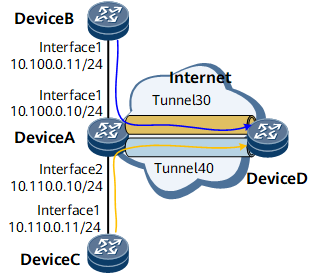Example for Configuring PBR Based on Redirection to an MPLS-TE P2P Tunnel
This section provides an example for configuring policy-based routing (PBR) based on redirection to an MPLS-TE P2P tunnel.
Networking Requirements
In Figure 1, a PBR policy named aaa needs to be configured on Device A. After the PBR policy is configured, if receiving packets from GE 0/1/0, Device A forwards all the packets with the source address of 10.100.0.11/24 to Tunnel30; if receiving packets from GE 0/1/8, Device A forwards all the packets with the source address of 10.110.0.11/24 to Tunnel 40. Device A is directly connected to Device B and Device C.

Interface 1 and Interface 2 in this example are GE 0/1/0 and GE 0/1/8, respectively.
Configuration Roadmap
The configuration roadmap is as follows:
Configure IP addresses for interfaces on Device A, Device B, Device C, and Device D.
Configure routes from Device B and Device C to Device D.
Define ACLs.
Configure rules and the action for PBR and apply PBR to an interface.
Data Preparation
To complete the configuration, you need the following data:
ACL numbers and rules
Name of a PBR policy
Outbound interface or next hop address to which packets are redirected
Procedure
- Configure IP addresses for interfaces on Device A, Device B, Device C, and Device D.
- Configure routes from Device B and Device C to Device D.
- Define an ACL on Device A.
# Define ACL 3001 to match the packets with the source address of 10.100.0.11/24 and ACL 3002 to match the packets with the source address of 10.110.0.11/24.
[~DeviceA] acl number 3001 [*DeviceA-acl4-advance-3001] rule 5 permit ip source 10.100.0.11 0.0.0.255 [*DeviceA-acl4-advance-3001] commit [~DeviceA-acl4-advance-3001] quit [~DeviceA] acl number 3002 [*DeviceA-acl4-advance-3002] rule 5 permit ip source 10.110.0.11 0.0.0.255 [*DeviceA-acl4-advance-3002] commit [~DeviceA-acl4-advance-3002] quit
- Configure rules and the action for PBR and apply PBR to an interface of Device A.
# Configure node 5 to forward packets with the source address of 10.100.0.11/24 to Tunnel 30.
[~DeviceA] interface Tunnel30 [*DeviceA] quit [*DeviceA] policy-based-route aaa permit node 5 [*DeviceA-policy-based-route-aaa-5] if-match acl name a3001 [*DeviceA-policy-based-route-aaa-5] apply output-interface Tunnel30 [*DeviceA-policy-based-route-aaa-5] commit [~DeviceA-policy-based-route-aaa-5] quit
# Configure node 10 to forward packets with the source address of 10.110.0.11/24 to Tunnel 40.
[~DeviceA] interface Tunnel40 [*DeviceA] quit [*DeviceA] policy-based-route aaa permit node 10 [*DeviceA-policy-based-route-aaa-10] if-match acl name a3002 [*DeviceA-policy-based-route-aaa-10] apply output-interface Tunnel40 [*DeviceA-policy-based-route-aaa-10] commit [~DeviceA-policy-based-route-aaa-10] quit
# Apply the PBR policy named aaa to GE 0/1/0.
[~DeviceA] interface gigabitethernet 0/1/0 [~DeviceA-GigabitEthernet0/1/0] ip address 10.100.0.10 255.255.255.0 [*DeviceA-GigabitEthernet0/1/0] ip policy-based-route aaa [*DeviceA-GigabitEthernet0/1/0] undo shutdown [*DeviceA-GigabitEthernet0/1/0] commit [~DeviceA-GigabitEthernet0/1/0] quit
# Apply the PBR policy named aaa to GE 0/1/8.
[~DeviceA] interface gigabitethernet 0/1/8 [~DeviceA-GigabitEthernet0/1/8] ip address 10.110.0.10 255.255.255.0 [*DeviceA-GigabitEthernet0/1/8] ip policy-based-route aaa [*DeviceA-GigabitEthernet0/1/8] undo shutdown [*DeviceA-GigabitEthernet0/1/8] commit [~DeviceA-GigabitEthernet0/1/8] quit [~DeviceA] quit
- Verify the configuration.
Run the display ip policy-based-route command. The command output shows the enabled PBR policies.
<DeviceA> display ip policy-based-route policy Name Interface aaa GigabitEthernet0/1/0 aaa GigabitEthernet0/1/8
Run the display policy-based-route command. The command output shows the created policy content.
<DeviceA> display policy-based-route ----------------------------------------------------- User Defined policy-based-route Policy Information: ----------------------------------------------------- Total: 100 Used: 1 Free: 99 Policy: aaa Node: 5 MapInstance: 5 if-match acl name a3001 apply output-interface Tunnel30 Node: 10 MapInstance: 10 if-match acl name a3002 apply output-interface Tunnel40
Configuration Files
Device A configuration file
# sysname DeviceA # acl number 3001 rule 5 permit ip source 10.100.0.11 0.0.0.255 acl number 3002 rule 5 permit ip source 10.110.0.11 0.0.0.255 # interface Tunnel30 # interface Tunnel40 # policy-based-route aaa permit node 5 map-instance 5 if-match acl name a3001 apply output-interface Tunnel30 policy-based-route aaa permit node 10 map-instance 10 if-match acl name a3002 apply output-interface Tunnel40 # interface GigabitEthernet0/1/0 undo shutdown ip address 10.100.0.10 255.255.255.0 ip policy-based-route aaa # interface GigabitEthernet0/1/8 undo shutdown ip address 10.110.0.10 255.255.255.0 ip policy-based-route aaa # return
Device B configuration file
# sysname DeviceB # interface GigabitEthernet0/1/0 undo shutdown ip address 10.100.0.11 255.255.255.0 # ip route-static 10.1.3.0 255.255.255.0 10.100.0.10 # return
Device C configuration file
# sysname DeviceC # interface GigabitEthernet0/1/0 undo shutdown ip address 10.110.0.11 255.255.255.0 # ip route-static 10.1.2.0 255.255.255.0 10.110.0.10 # return
